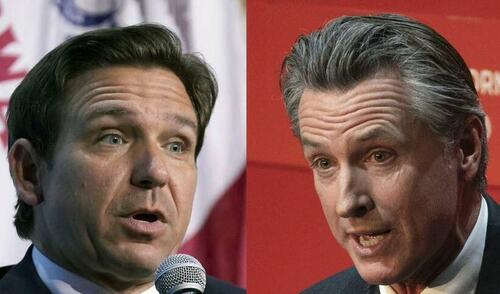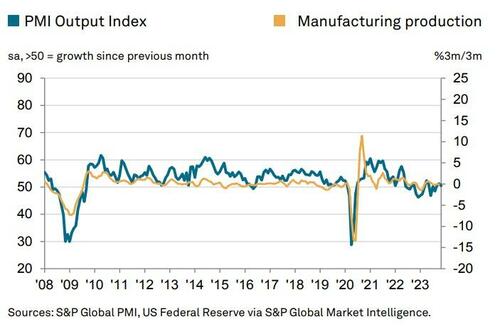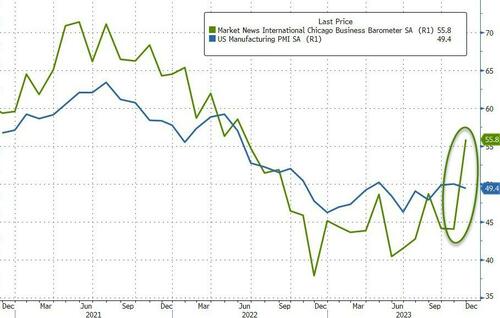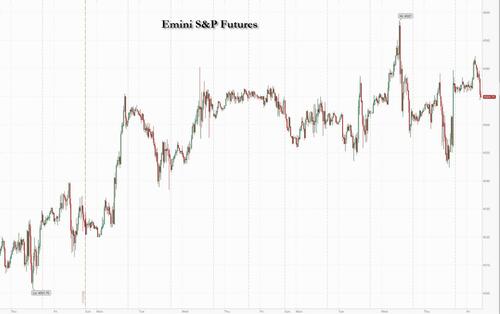While we seem to be heading for a rematch between Biden and Trump in the 2024 US presidential election, Fox hosted a debate between Governor Gavin Newsom (Democrat, California) and Governor Ron DeSantis (Republican, Florida), which can either be seen as an early presidential debate for 2028 or a debate between two reserve-candidates for 2024.
DeSantis probably hoped to boost his chances in the current Republican primaries, after Nikki Haley’s campaign to be the main challenger to Trump has gained momentum.

And indeed, the Red State vs. Blue State debate between Govs. DeSantis and Newsom was truly a sight to behold.

As Matt Margolis writes at PJMedia.com, it was amusing to see how DeSantis was armed with the facts, and Newsom was so impotent that he simply refused to answer question after question, instead choosing to launch into generic talking points, avoiding the substance of the issues being discussed.
Time after time, he was presented with raw data – facts comparing California and Florida – on migration, crime, jobs, COVID, etc., and Newsom’s response each time was to simply deny the facts and make up his own story.
I don’t think I’ve ever seen a debate where a person evaded questions as much as Gavin Newsom did Thursday evening.
For someone who is routinely hailed as an expert debater and suave politician, he made it clear that he couldn’t defend the indefensible.
While there were a number of good lines, The Epoch Times’ Nathan Worcester and T.J. Muscaro highlight the five key takeaways from the 2028 dress-rehearsal (perhaps):
Interstate Migration
Early in the debate Mr. Newsom and Mr. DeSantis sparred over the rate of migration to and from their respective states.
The exchange began after Mr. Hannity asked about the high rates of outmigration from California and some other blue states. Meanwhile, Florida and some other red states have grown.
“He’s the first governor to ever lose population,” Mr. DeSantis said of Mr. Newsom.
“I think California has more natural advantages than any state in the country. You almost have to try to mess California up,” he said.
The California governor claimed that over the last two years, there were “more Floridians going to California than Californians going to Florida.”
“That’s gonna be fun to fact check,” he added.
But U.S. Census data show that more Californians have moved to Florida than vice-versa in 2021 and 2022.
Some fact-checkers have asserted that California’s state executive was referring to migration per capita rather than the raw numbers.
Whatever the case may be, the Fox News-hosted event allowed refugees from the Golden State to say their piece. At a press conference prior to the Thursday night spectacle, seven new Floridians told reporters why they had departed from the Golden State.
“In 2022 we had had enough,” said Steve Grossi, a law enforcement officer who spent a few years with the Sutter County Sheriff’s Department near Yuba City, California.
“We were fed up. We were angry. We were scared. It was so bad that we can no longer survive here. The California that we once knew no longer existed,” he added.
Taxes
Mr. DeSantis and Mr. Newsom also focused on the difference in their state’s tax policies. Mr. Hannity opened with statistics from the Tax Foundation, which showed Florida’s taxes alongside California’s.
Florida features a lower sales tax (6 percent compared to California’s 7.25 percent), lower gas tax (35.23 cents per gallon compared to California’s 77.9 cents per gallon), and a lower corporate income tax (5.50 percent compared to California’s 8.84 percent). Florida also boasts no individual income tax, while California features a maximum 13.3 percent income tax rate.
The Sunshine State only out-taxes the Golden State in terms of property taxes 0.91 percent on average compared to California’s 0.75 percent.
Mr. Newsom said that his state had the highest income tax rate rather than the highest state income taxes, which was a “foundational, fundamental difference.” He argued that states like Florida tax lower-income earners more than he does in his state.
“How many people wanted to go to California because they pay less taxes,” Mr. DeSantis asked. “I have not seen that.”
They come to Florida, he said, for lower taxes.
Mr. DeSantis also emphasized the fact his state has no state income tax, and the sales tax in place is still lower than that of California.
Pandemic Policy
Mr. Newsom also questioned Mr. DeSantis’s actions in relation to the COVID-19 pandemic.
The Florida governor broached the issue when Mr. Newsom brought up Disney. The corporation, long a cornerstone of the state’s economy, has been at odds with Mr. DeSantis over the Florida Parental Rights in Education Act.
“I think that’s an interesting point with Disney because I had Disney open during COVID, and we made them a fortune, and we saved a lot of jobs. You had Disney closed inexplicably for over a year,” the Florida governor said.
Disneyland, located in Anaheim, California, was shuttered for 13 months.
“In the past year, Anaheim has been through one of the most challenging years in its history,” Anaheim spokesperson Mike Lyster told The Epoch Times in 2021.
Mr. Newsom soon fired back, arguing that the governor’s record was less liberty-oriented than he let on.
“You passed an emergency declaration before the State of California did,” he said.
Mr. DeSantis declared a public health emergency regarding COVID-19 on March 1, 2020. Mr. Newsom proclaimed a State of Emergency over the coronavirus just days later, on March 4, 2020.
Other topics included COVID-19 death rates in the two states as well as the impact of lockdowns on education.
A National Bureau of Economic Research report card found that California had the least in-person learning of any state in the nation during the 2020–2021 school year, at just 19.2 percent. They outpaced the District of Columbia, in which just 5.8 percent of learning was in person that school year.
Parents Rights Bill
The governors also shared their views on parental rights when it comes to education and LGBT influence on kids.
Mr. DeSantis signed the Parental Rights in Education Bill during his first term as governor. It was labeled by dissenters as the “Don’t Say Gay Bill.” The law prevented matters of gender identity and sexual orientation from being taught to kids in kindergarten through third grade and prohibited schools from defying parents and hiding information from them when it comes to affirming a child’s gender identity.
The Florida law was written in response to national concerns about LGBT indoctrination in schools and attempts elsewhere to shut parents out of what happens when their children are in school.
“What we’ve said in Florida is it’s inappropriate to tell a kindergartener that their gender is a choice,” Mr. DeSantis said. “It’s inappropriate to tell second graders that they may have been born in the wrong body. Now California has that. They want to have that injected into the elementary school.”
Mr. DeSantis brought a copy of a page from one of these books showing examples of explicit sexual acts, partly censored for the TV audience.
The Republican then pointed to a California law that allows minors to travel to the state for transgender procedures.
“If you’re a parent in Iowa or New Hampshire or South Carolina, your minor child can go to California without your knowledge or without your consent and get hormone therapy, puberty blockers, and a sex change operation,” Mr. DeSantis said. “That is extreme. That is an assault on parents’ rights.”
Meanwhile, Mr. Newsom accused Mr. DeSantis of being on a “banning binge” and that he “demeans” the LGBT community through his policies.
“What you’re doing is using education as a sword for your cultural purge,” the California governor said.
Crime
Mr. DeSantis and Mr. Newsom also debated crime and shootings.
The quality of life differences between the two states were a constant undercurrent of the debate. Again – like a San Franciscan using the poop map app – Newsom repeatedly side-stepped the issue, baldly claiming California’s crime and homelessness issues are not really that bad and Florida has a city with a lot of murders, more than “even San Francisco.”
Mr. Hannity had asked about the higher rate of violent crime in California as compared to Florida, comparing two figures that combined homicide, rape, and other offenses in a single year.
But Mr. Newsom reframed the topic by narrowing it. He pointed out that Florida has a higher murder rate than California. Indeed, the homicide death rate in Florida was higher than that of California in 2021 according to statistics from the Centers for Disease Control and Prevention.
Experts have questioned the utility of comparisons of murder rates between states.
“State-level data is not very useful. States have both urban and rural areas—and policing is a local decision in cities, which tend to be Democratically controlled even in Republican states,” economist John Lott told The Epoch Times in 2022.
“People are leaving California in droves largely because public safety has collapsed,” Mr. DeSantis asserted, claiming that the state has “basically legalized retail theft.”
In California, stealing items under $950 is just a misdemeanor. The Hoover Institution’s Lee Ohanian has argued that the standard means “shoplifting is now de facto legal in California.”
Mr. Newsom also took issue with Mr. DeSantis’s past talk of pardoning people arrested in connection with the protests and riots in Washington on Jan. 6. While much of his rhetoric seemed to be aimed at a broader audience than liberal Democrats, the California governor and possible future presidential candidate didn’t shy away from more politically charged language when describing those individuals.
“I love this guy talking about ‘Backing the Blue’ when you dangled pardons for January 6th insurrectionists,” Mr. Newsom said.
* * *
Donald Trump’s name was only invoked in the debate when Gavin “DeSantis Is Being Mean to People” Newsom used it to ridicule DeSantis.
Finally, as Paula Bolyard writes at PJMedia.com, when all was said and done, both men performed well, although Newsom frequently relied on lies to make his points.
I admit I’m biased, but Newsom came across as smarmy and artificially enhanced (by Botox and whatnot), even trotting out a fake Southern accent several times during the debate. At certain points, it felt like he was trying to channel Bill Clinton, which was super weird.
DeSantis looked competent and was confident he was on the right side of every policy issue discussed. He apologized for nothing and was consistent in calling out Newsom’s incompetence and malfeasance.
In the post-game show, former White House spokesman Ari Fleischer said the debate proved that “Democrats are from Mars and Republicans are from Venus.”
He said DeSantis was “very practical, very focused on people’s daily lives,” while Newsom’s “whole message was identity politics.”
“I thought Governor DeSantis did a pretty good job tonight defending his state and his record,” he added. He gave the Florida governor a B+ for his factual performance but a B- because he didn’t look Newsom in the eye enough. He gave Newsom a “D in terms of mangling the facts.”
Democrat operative Harold Ford gave both a B+ and praised DeSantis’s performance.
Former Congressman Jason Chaffetz said DeSantis looked “presidential” and “his disposition and demeanor were spot on.”
He predicted that the Florida governor would rise in the polls as a result of his performance.
Former Trump Press Secretary Kayleigh McEnany said of Newsom, “In terms of being glib, yeah, I would give him an A.”
She gave DeSantis an A but warned that Newsom is “a sharp messenger.” “Watch out, he’s coming,” she added.
Newsom swears (pinky promise!) that he’s not running a shadow campaign for president, but the only person who believes that whopper is the doddering Joe Biden.

















